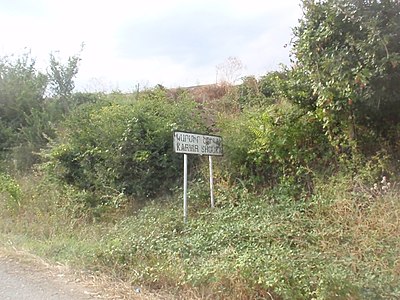| Karmir Shuka / Girmizi Bazar Կարմիր Շուկա / Qırmızı Bazar | |
|---|---|
 | |
  | |
| Coordinates: 39°40′33″N 46°56′55″E / 39.67583°N 46.94861°E / 39.67583; 46.94861 | |
| Country | |
| • District | Khojavend |
| Population | |
| • Total | 1,113 |
| Time zone | UTC+4 (AZT) |
Karmir Shuka (Armenian: Կարմիր Շուկա) or Girmizi Bazar (Azerbaijani: Qırmızı Bazar) is a village in the Khojavend District of Azerbaijan, in the region of Nagorno-Karabakh. Until 2023 it was controlled by the breakaway Republic of Artsakh. The village had an ethnic Armenian-majority population until the exodus of the Armenian population of Nagorno-Karabakh following the 2023 Azerbaijani offensive in Nagorno-Karabakh.
Etymology
The name of the village was Krasny Bazar (Russian: Красный Базар) during the Soviet Union, meaning "Red Market" in Russian. The Armenian name, and the Azerbaijani rendering, also mean "Red Market".
History
During the Soviet period, the village was a part of the Martuni District of the Nagorno-Karabakh Autonomous Oblast.
Historical heritage sites
Historical heritage sites in and around the village include Tnjri, a 2,000-year-old Oriental Plane, the 12th/13th-century village of Mavas (Armenian: Մավաս), a 12th/13th-century khachkar, a cemetery from between the 17th and 18th centuries, the 17th-century monastic complex of Yerek Mankuk (Armenian: Երեք մանկուք) in Mavas, the church of Surb Astvatsatsin (Armenian: Սուրբ Աստվածածին, lit. 'Holy Mother of God') built in 1731 near the nearby village of Skhtorashen, and the 18th-century St. George's Chapel Church (Armenian: Սուրբ Գևորգ մատուռ-եկեղեցի, romanized: Surb Gevorg Matur-Yekeghetsi).
Economy and culture
The population is mainly engaged in agriculture and animal husbandry. As of 2015, the village has a municipal building, a house of culture, a secondary school, a kindergarten, eight shops, and a medical centre. The community of Karmir Shuka includes the village of Skhtorashen.
Demographics
The village had 926 inhabitants in 2005, and 1,113 inhabitants in 2015.
Gallery
-
 A sign at the entrance of the village on the north–south highway in Nagorno-Karabakh.
A sign at the entrance of the village on the north–south highway in Nagorno-Karabakh.
-
 Tnjri, a 2,000-year-old Oriental Plane between the village and Skhtorashen.
Tnjri, a 2,000-year-old Oriental Plane between the village and Skhtorashen.
References
- ^ Hakob Ghahramanyan. "Directory of socio-economic characteristics of NKR administrative-territorial units (2015)".
- Андрей Зубов. "Андрей Зубов. Карабах: Мир и Война". drugoivzgliad.com.
- Sauer, Pjotr (2 October 2023). "'It's a ghost town': UN arrives in Nagorno-Karabakh to find ethnic Armenians have fled". The Guardian. ISSN 0261-3077. Retrieved 9 November 2023.
- Everett-Heath, John (2020). "Gyrmyzy Bazar". The Concise Dictionary of World Place-Names (6 ed.). Oxford University Press. ISBN 978-0191905636.
- Kiesling, Brady; Kojian, Raffi (2019). Rediscovering Armenia: An in-depth inventory of villages and monuments in Armenia and Artsakh (3rd ed.). Armeniapedia Publishing.
- "The Results of the 2005 Census of the Nagorno-Karabakh Republic" (PDF). National Statistic Service of the Republic of Artsakh.
